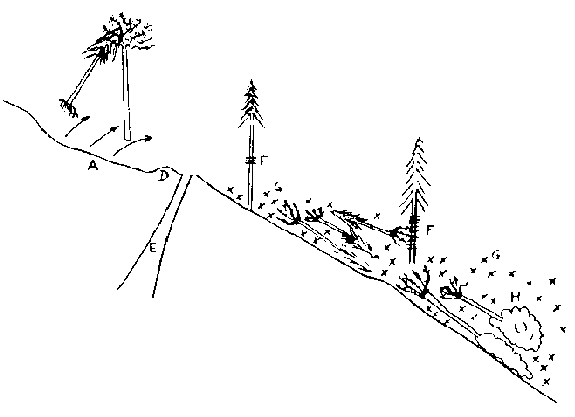 |
Science Frontiers ONLINE No. 120: Nov-Dec 1998 |
|
|
A Bright Flying Object And Another Enigmatic Crater
The curious event described in the following abstract is eerily like the fireball and suspicious "crater" mentioned in SF#110. In that incident, which occurred November 22, 1996, near the HondurasGuatemala border, there was also a detonation.
"On the early morning of 1994 January 18, a very bright luminous object crossed the sky of Santiago de Compostela, Spain. From visual sightings, it is concluded that the object wasn't a meteoric fireball (bolide). A surface "crater" in Cando (close to Santiago) with dimensions 29 x 13 m and 1.5 m deep was later discovered within 1 km of the projected "impact" point of the luminous object. At this site, in addition to the topsoil, full-grown pine trees greater than 20 m high were thrown downhill over a nearby road, leaving the downslope edge of the "crater" untouched and with a steep interior wall (this would not be the case if a regular landslide were responsible for the transport). Standing trees below the "crater" showed embedded soil and plant residues up to heights greater than 3 m. No strange materials (meteorites or artifacts) were recovered in or close to the "crater"; all materials belonged to the site and were not shocked; thus an impact is very improbable.
"A possible explanation capable of reconciling all of the observations is presented. It hypothesizes an eruption of earth gases to create the crater, with the rising gas plume then interacting with atmospheric electricity to produce the propagating fireball that was observed."
(Docobo, J.A., et al; "Investigation of a Bright Flying Object over Northwest Spain, 1994 January 18," Meteoritics and Planetary Science, 33:57, 1998.)
Comments. We cannot resist associating these strange "craters" with the even stranger "cookie-cutter" holes or shallow "craters" reported in SF#37 and in more detail in ETB7 in our catalog Carolina Bays, Mima Mounds, etc.
In a bizarre coincidence, the fireball item of SF#110 is immediately preceded by a suggestion by R. Spaulding that TWA800 was downed by a methane eruption from the sea which ignited, thereby leading to the several observations of streaks of light prior to that disaster. And who is the secondlisted author of the paper abstracted above? None other than R. Spaulding!!
 |
|
(A) The shallow Spanish "crater" (D) "crater" lip (E) walkway (F) trees plastered with soil (G) soild thrown from "crater" (H) trees 0.6-meter (2-feet) in diameter thrown down the slope. |